
St. Olaf Kirke, commonly referred to as The Rock Church, is a small Lutheran church located outside of Cranfills Gap, Texas, United States, in an unincorporated rural community known as Norse in Bosque County, Texas. The Church is affiliated with the Evangelical Lutheran Church in America.

Bethany Memorial Chapel was built by Norwegian homesteaders who settled in the Big Bear Ridge area north of Kendrick in rural Latah County, Idaho. Norwegians who had settled in the area met at the home of Edward Dahl on July 21, 1902, for the purpose of organizing a Lutheran church in the area. In late July 1902, plans were prepared for the building, which was to be constructed on one-half acre of land promised by Edward Jones. However, Jones had sold his land to Halvor Nelson, who then added another one-half acre to the property. Construction of the Carpenter Gothic building began in 1905 and was completed, inside and out, in 1908. Although the interior of the building had not yet been completed, the first service in the church took place on December 26, 1905, when Halvor Lien married Hilda Slind. The pews, altar railing, and pulpit were carved by Eric Leien, a member of the congregation. It was originally named the Evangelical Lutheran Church, Bethany Congregation of Kendrick. There is no longer an active congregation holding services, but the church and cemetery are maintained by community members.

The Norwegian Lutheran Church in the United States is a general term to describe the Lutheran church tradition developed within the United States by immigrants from Norway.
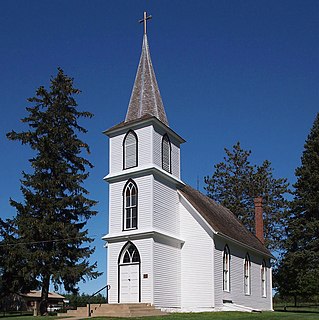
Christdala Evangelical Swedish Lutheran Church is a historic church located in Forest Township, Rice County, Minnesota. It is situated 11 miles (18 km) west of Northfield at 4695 Millersburg Blvd.
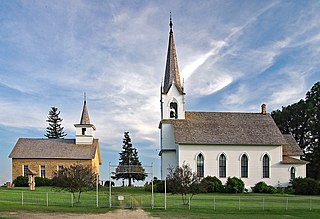
Valley Grove is a historic Lutheran church complex in Wheeling Township, Minnesota, United States. It consists of two 19th-century churches surrounded by a hilltop cemetery. The older building was constructed in stone in 1862 by a rural community of Norwegian immigrants. The congregation outgrew the first church and constructed a larger, wooden replacement in 1894, converting the original building into a guild hall. The property was listed on the National Register of Historic Places in 1982 for its local significance in the themes of architecture, art, and religion. It was nominated for encapsulating two phases of rural ecclesiastical architecture in a dramatic hilltop tableau, and for its role in anchoring eastern Rice County's dispersed community of Norwegian immigrants.

Grace University Lutheran Church is a church in Minneapolis, Minnesota, United States, adjacent to the University of Minnesota East Bank campus. The church was built in 1915–1917 by a Swedish Lutheran congregation to serve neighborhood families and university students. It was designed by Chapman and Magney and built in the Gothic Revival style.

Chestnut Ridge and Schellsburg Union Church and Cemetery is a historic church and cemetery in Bedford County, Pennsylvania. The church was built by members of the Reformed and Lutheran churches in 1806. It was used by both congregations until 1843, and then by the Reformed congregation until 1853. The first burial in the cemetery was in 1806, while the church was being constructed. Workmen who were roofing the church placed a child named Whetstone in an unmarked grave. Nevertheless, the cemetery was not formally organized until 1860, and did not receive a deed to the land until 1897.

Center City Historic District is a grouping of 19 homes and one church located along the east side of Summit Avenue situated on a hill overlooking North Center Lake in Center City, Minnesota, United States. It was listed as a historic district on the National Register of Historic Places in 1980. Center City became the county seat of Chisago County in the 1870s, during a time of Swedish migration and settlement in the county. The buildings in the historic district include the Chisago Lake Evangelical Lutheran Church, which was the main Swedish Lutheran parish in the area, as well as a number of residences built between 1888 and 1910. The homes have moderate ornamentation and attention to architectural styling details of their period.

Old East Paint Creek Lutheran Church is located north of Waterville, Iowa, United States. The church building was listed on the National Register of Historic Places in 1983.

Saint John's Lutheran Church is an active church building located at 121 South Locust Street in the city of Adrian in Lenawee County, Michigan. It was designated as a Michigan State Historic State on February 23, 1981 and shortly after listed on the National Register of Historic Places on December 27, 1984. The Lutheran congregation moved to a new home in 2007, and the church building now houses the Reformed Baptist Church of Lenawee.
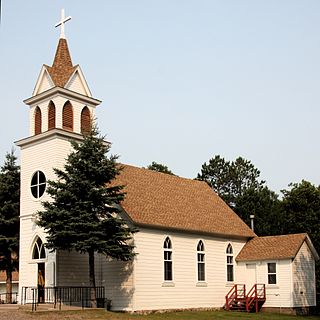
Bethlehem Lutheran Church is a historic Lutheran church in Nordland Township, Minnesota, United States. The church was constructed in 1897 by Swedish immigrants. The Gothic Revival building features a square tower topped by a belfry and an octagonal spire. The church's congregation formed in 1891 and was the second of five Swedish Lutheran churches established in the county. Aitkin County received a large influx of Swedish immigrants in the late 1800s, and the church is one of the best-preserved buildings constructed by the immigrant population upon their arrival.

Clearwater Evangelical Lutheran Church is a rural former place of worship near the Clearwater River in Equality Township, Red Lake County, Minnesota. It served a congregation of Norwegian Americans which organized in 1898 under the name Clearwater Norwegian Evangelical Lutheran Church of America. Before building the church, they met in homes and log schoolhouses.

Christiania Lutheran Free Church is a historic church in Eureka Township, Minnesota, United States. The church is located at 26690 Highview Avenue approximately nine miles (14 km) southwest of Farmington, Minnesota.

Hauge Lutheran Church is a historic church in Kenyon Township, Goodhue County, Minnesota.
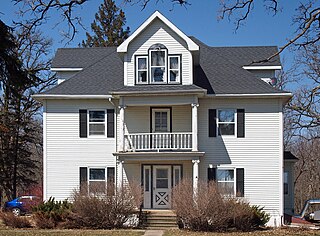
Holden Lutheran Church Parsonage is a historic church parsonage at Kenyon in Wanamingo Township, Goodhue County, Minnesota. The building is located on the north side of Goodhue County Highway 8. The building was added to the National Register in 1980.
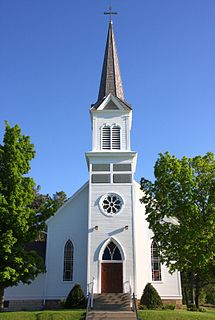
Immanuel Lutheran Church is a historic church in Hay Creek Township, Goodhue County, Minnesota, Goodhue County, Minnesota, United States, near the city of Red Wing. The congregation was organized in 1858 by German Lutheran families who had settled in Flower Valley. Their first pastor, William Wier, came to administer the sacrament twice a year through the summer of 1861. The first church building was a three-room building completed around 1862. A number of German Lutherans in the southern part of the township wanted to join the Immanuel congregation, so the congregation established a northern district and a southern district. This arrangement continued for a while until the building in Flower Valley was moved to the current location in Hay Creek in 1868. The land in Hay Creek consisted of two acres donated by a Mr. W. Plote.

The Swedish Evangelical Lutheran Church is a historic church building in Millville, Minnesota, United States. It was built in 1874 and used successively by Swedish, Norwegian, and German immigrant congregations. The church and its adjacent cemetery were listed on the National Register of Historic Places in 1989 for having local significance in the theme of European ethnic heritage. It was nominated for being the only intact surviving ethnic church from the peak of European immigration to Wabasha County.

Sheldahl First Norwegian Evangelical Lutheran Church is a historic building located in Sheldahl, Iowa, United States. The community was platted by Osmund Sheldahl and J.S. Polk. Sheldahl was a lay Lutheran minister who settled in Illinois in 1845. He and three others came to this area in 1854 in search of cheap available land. The following year, 21 families that had organized themselves as the "Palestine Congregation" relocated to Story County. Sheldahl became a large land owner and the regular pastor for Palestine Lutheran Church in 1860. He built a house in town in 1877 and he and his two sons built this church building in 1883. Osmund Sheldahl served the congregation as an unpaid pastor for 13 years. His will stipulated that the church building be made available to any Christian denomination that emphasized Bible teaching. It remained in regular use until 1936.

Trinity Lutheran Church, also known as St. Edward's Catholic Church, is a historic church building located in Henning, Minnesota, United States. The Lutheran congregation was established in 1878. The brick Gothic Revival church was built in 1898. The twin spires on top of the central tower is a unique feature of the building. It was also one of the first structures built in town. Two other Lutheran congregations were founded in the area in the late 19th-century, Norderhaug Norwegian Evangelical Lutheran Church in 1887, and United Lutheran Church in 1896. Those two congregations merged in 1957 and Trinity joined them ten years later, forming Good Shepherd Lutheran Church. St. Edward's Catholic Church acquired the Trinity church building shortly after that. They moved to a new building in 2002 and sold the old church.

Christ Lutheran Church on Capitol Hill is a congregation of the Evangelical Lutheran Church in America (ELCA) in the Thomas-Dale neighborhood of Saint Paul, Minnesota, United States.






















